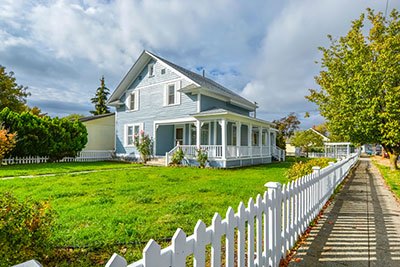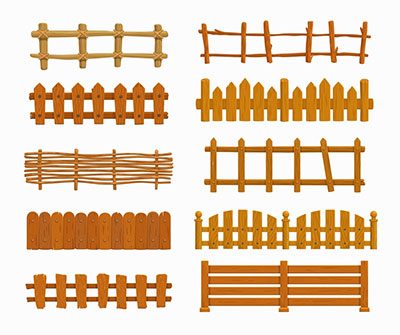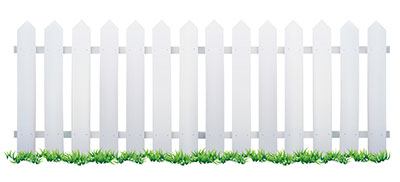Are you interested in understanding what exactly a picket fence is? If so, keep reading our blog post to learn all about this classic and attractive fencing option!
In this article, we’ll discuss the different materials available, how they are typically designed, their benefits, and other useful picket fence facts. We’ll even provide insights into why these fences remain such a popular choice for homeowners!
Read on to unlock your knowledge of why this traditional outdoor boundary still adds character and charm to many properties today.
Take away key points:
- Picket fences are popular due to their look and attraction
- They can be shorter or taller, depending on your needs, and you can find different materials to create your beautiful oasis
- They also come with different parts and require more or less material to maintain regularly, so ensure you protect them from the sun, the stain, and other damage
Table of Contents
- Picket fences: The most popular fencing model for homeowners
- FAQs
- Final verdict
Picket fences: The most popular fencing model for homeowners
If you need to know more about a picket fence, its history, use, benefits, and other crucial factors to choose the best model, read our guide below.
We will provide answers to all your questions.
What is a picket fence & its purpose?

A picket fence is a type of fence made up of evenly spaced vertical boards (pickets) that are attached to horizontal rails. It is often used decoratively for domestic boundaries and is a classic fencing system that offers a good mix of security and aesthetics.
Picket fences were originally used by American colonists to keep livestock and chickens out of their gardens while offering protection to their crops. Today, they remain a popular choice for those who want a fence that is both decorative and functional, with a maintenance-free system.
The pickets, also known as slats or boards – horizontal rails or vertical slats, make up the body of the fence and attach to the backer rails with nails or screws.
History of picket fences
Traditional picket fences have been popular in the United States since the country’s earliest colonial era. Picket-style fences were originally handcrafted with simple designs and made from wood as the most common material.
The name “picket fence” comes from the evenly spaced vertical boards, called pickets, that make up the majority of the fence structure.
As mass production became more affordable in the 19th century, fancier and cheaper fence parts became available, which made picket fences more popular across the country.
The first picket fences were unpainted, but as white paint became cheap and readily available, people started painting their fences white. This made their fences visible during the day and night, as well as a symbol of wealth and class.
Additionally, in the Colonial Revival design movement of 1876, the picket fence became more popular than ever for its custom look and its ornaments – flowers, lights, etc.
Today, the picket fence remains an iconic symbol of American homes and is still widely used. Its classic design showcases a sense of style, class, and prosperity.
Why is a classic white picket fence so popular?
One reason could be the symbolism of the fence itself. A white picket fence is often associated with the idea of safety and security, creating a clear boundary between your property and the outside world.
Additionally, white paint is often associated with purity, cleanliness, and simplicity, which can appeal to many owners of their spaces.
Another reason for the popularity of the white picket fence could be cultural influence. Picket fences have been a fixture of American suburbs since the 1950s and have come to symbolize the ‘ideal‘ middle-class suburban life. The white picket fence represents the American Dream.
Different types of picket fences
There are various types of picket fences available in the market today, each with its unique style and features. Here are some of the most common types:
1. Wood picket fence

These are the traditional-looking picket fences that are typically made of cypress, spruce, cedar, redwood, and treated pine. Wooden picket fences offer a rustic and natural appeal to your home.
2. Vinyl picket fence
A vinyl picket fence is low-maintenance and incredibly durable. These perfect picket fence models are available in various colors and styles.
So the cellular PVC model for your new fence is an attractive option for many owners and your house, property, or yard.
3. Metal picket fence
Metal picket fences, including aluminum and wrought iron, provide a more modern and sophisticated look to your property. They are also highly durable and require low maintenance. Wrought iron picket fences also resist strong winds and stand firm in different spaces.
4. Composite picket fence
Composite picket fences are made of recycled materials and offer the look of wood with the durability of plastic. They are a great eco-friendly option for those who want the traditional look of a picket fence without the upkeep of wooden fences.
No matter which type of picket fence you choose, it can add charm, style, and value to your home.
Anatomy of picket fences
Understanding the anatomy of picket fencing can help you make an informed decision when buying or installing one.
Here are the crucial parts the picket fence systems offer:
– Pickets/Balusters: These are the vertical boards that make up the body of the fence, and they are the most visible part of the fence. They are called pickets, and they can be customized in size and shape to create different designs.
– Posts: These are the vertical support structures of the fence, and they are traditionally buried deep into the ground to ensure the stability of the posts and are easy to install. They support the weight of the fence.
– Rails: These are the horizontal boards that connect the posts and the pickets, providing rigidity to the fence. traditionally, the top rail provides support to the pickets, while the bottom rail keeps them in place.
How to install a picket fence
Installing a picket fence can add charm and privacy to your home. Here are the steps to get you started:
– Set the fence posts: Dig a hole for each post, make sure they are level, and pour concrete to hold them in place.
– Install the rails: Slide the panel’s rails into the post’s mortises, then prop up the panel’s far end with wood wedges. Adjust them until the top rail is level.
– Attach the pickets: Create guides for the picket tops, attach support boards at the gateposts, then begin attaching the first pickets. Make sure they are plumb and evenly spaced.
– Add finishing touches: For a solid privacy fence, turn the pickets against each other without leaving gaps. Creating a spacer will help maintain a consistent gap between the pickets. You will have equal spacing to keep privacy and protect your dog, children, lawn, yard, and house in general from intruders.
Remember, having a helper will make the installation go much quicker. With these simple steps, you’ll soon have a beautiful and sturdy picket fence to enjoy.
Regular maintenance tips for picket fences
If you’re a proud owner of a picket fence, you know how it can add charm to your house and property. To keep it in good condition, here are some tips to maintain it:
– Regular cleaning: Keep your fence clean by washing it down with water and a mild detergent to remove dirt and grime buildup.
– Inspect for damage: Check your fence for any signs of damage such as rotting, warping, or loose pickets. Address these issues as soon as possible to avoid further damage.
– Apply sealant: Applying a sealant will help protect your fence from weather damage and increase its lifespan. Consider using a waterproof sealant for added protection and a rot-resistant system if you use a wood fence (redwood, cedar, timber). Also, apply protection for your aluminum, vinyl, steel, or metal fences and keep the clean lines for more durability.
– Trim plant growth: Overgrown plants can damage your fence pickets and posts. Trim any plant growth that is close to your fence to prevent this from happening, and keep the gate clean for easier use.
– Don’t lean on the fence: Picket fences may look charming but they’re not meant to support the weight of a person. Avoid leaning or sitting on the fence to prevent any damage. Teach your children the same rules, otherwise, they can damage the gates and pickets.
Pros & Cons of picket fencing

Before deciding on installing a picket fence for your property, it’s important to weigh the pros and cons of this type of fencing.
Here are some things to consider:
Pros
– Picket fences are an affordable option compared to other fencing materials and styles.
– They are versatile and come in a variety of materials such as wood – cedar, timber, redwood, steel, metal, vinyl, and aluminum.
– Picket fences provide a clear boundary for your property and are great for keeping both kids and pets in or out of your yard, porch, garden, etc.
– They offer security without looking too aggressive or unfriendly.
– Picket fences are a timeless design choice and can complement any home style.
Cons
– Maintenance is necessary to keep picket fences looking their best, and the frequency of maintenance depends on the material. For instance, wood picket fences require more maintenance than vinyl picket or metal picket fences.
– Picket fences do not provide much privacy as they have large gaps between the pickets, which may not be suitable for some homeowners with children and pets.
– White picket fences, in particular, can look dirty without proper maintenance and cleaning.
FAQs
What is the difference between a picket fence and privacy?
The main difference between a picket fence and a privacy fence is its purpose.
A picket fence is primarily used for visual appeal and to add curb appeal to a property. It is typically shorter, around three to four feet, and has spaces between the pickets that allow airflow and visibility.
On the other hand, a privacy fence is designed to provide privacy and security. It is usually taller, around 6 to 8 feet, and has no spaces between the panels, making it difficult for anyone to see inside the property
Why use a picket fence?
Picket fences are often used for decorative purposes, providing functional boundaries while adding an aesthetically pleasing feature to a property. They are commonly made of wood and can come in various styles and designs, such as spaced picket fence panels or vinyl white picket fencing.
Can you spray-paint a picket fence?
Yes, you can spray-paint a picket fence, but you must be careful not to get paint on any uncovered plants while spraying. Before painting, make sure to scrape off any peeling or old paint and clean the fence thoroughly.
For best results, use a paint that is mold and mildew-resistant and protects against UV rays. You can paint the fence using a narrow roller to speed up the process.
Where can I buy picket fence panels?
You can visit local stores with such parts, or find them on Amazon.
How to keep fence pickets level on any ground?
To keep fence pickets level on uneven ground, it is important to follow these steps:
– Determine the height of your fence posts.
– Dig the post holes to the appropriate depth.
– Put up a fence post and use a line level to level it.
– Fix the next fence post using the same method.
– Stretch a line of string between the two posts to establish the fence line.
– Use a line level to adjust the height of the string as needed.
– Go to one end and put up a picket, making sure it is level with the string.
– Assembly the pickets one by one, ensuring that each one is level with the string.
Can fence panels be higher than posts?
Yes, panels can be higher than posts. However, it’s important to note that increasing the height of your fencing panels will increase the wind load on your fence, and as such, strong fence posts are required.
Posts are typically designed to support fence panels 2ft shorter than themselves, so if you plan on having higher fence panels, you’ll need taller posts to ensure stability and strength.
Final verdict
Picket fencing is a good reason to beautify your household and increase its attraction. You can easily find different models – metal, wood, and vinyl, with rot-resistant, UV-resistant, and similar benefits. Maintain them regularly for the best look.
